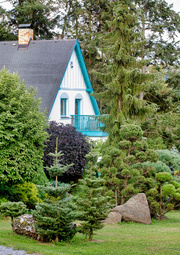Prioritizing Connectivity and Safety in Remote Living
Living off the beaten track is a great way to unplug from modern life and reconnect with nature. Rather than spending their days walking on sidewalks, your kids will get to play in woodlands, run up hillsides, and chase unsuspecting bugs around your yard. This improves their health and boosts their well-being.
Rural life can be just as fulfilling and lucrative as urban life today. Most children can attend remote schools, meaning they can still access top-quality learning from home. Similarly, you can work from home while living in the countryside and earn the same salary that your friends in the city bring home.
However, working remotely does mean you have to prioritize connectivity and safety when making decisions about your home. You’ll need a reliable, stable connection and should take steps to protect your family when living outside of the city limits. This will help you create a secure environment where your kids will thrive and will ensure that you can become just as productive as your office-bound peers.
Safety
Moving to the countryside may sound like a great way to avoid crime and shield your children from the chaos that comes with urban living. However, there has been a surge in rural crime in recent years. While it’s impossible to pinpoint why, exactly, crime is on the rise in rural areas, some suggest that heightened stress due to the pandemic is continuing to play a role.
You don’t need to convert your home into Fort Knox to feel safe while living in the countryside. Instead, take sensible measures to protect your family while improving your connectivity and saftey. Invest in an alarm system and set up some motion-sensor lights. If you want to appease your children and bolster your safety, consider getting a dog who will act as a natural deterrent for any potential burglars.
You can speak to your kids to ensure that they know how to stay safe when playing in the great outdoors, too. For example, if there’s been heavy rainfall, consider teaching your children about mud safety. While exposure to bacteria and bugs may strengthen their immune system, your kids should know not to put mud anywhere near their mouths or open wounds. Some mud is contaminated with toxic chemicals and tetanus bacteria, meaning children should exercise at least a little caution before diving into the first puddle they find.
Connectivity
Living away from the city means you’ll need to forgo some of modern life’s simple pleasures. You probably can’t order a macchiato on Uber Eats and you may struggle to find cell service while hiking in the great outdoors. However, before you make the move, you need to ensure that you have a stable, reliable internet connection. When shopping for WiFi, consider different types of internet for rural areas, including:
- DSL: DSL internet is connected via phone lines and has been on offer since the 1990s. Just be aware that DSL can be slow compared to more modern forms of internet, and will offer download speeds between 1.4 – 15 Mbps.
- Fiber: Fiber is not available in most rural locations. But, if it is, it is almost certainly your best option. As federal funding expands to rural infrastructure, expect to see more fiber availability in your area.
- Fixed Wireless: Fixed services broadcast from towers into a receiver in your home. This is similar to cellular networks, but typically offers greater WiFi speeds as you are not “sharing” the network with all the other phones in your area. This means you can expect speeds between 20 -50Mbps while working from home.
- Satellite: As long as your home has clear access to the southern sky, you can use satellite internet. Providers like Viasat boast speeds of up to 150Mbps, but you will have a cap on the amount of broadband that you can use per month.
Finding the right broadband provider for you is crucial if you want to prioritize connectivity and saftey while living remotely. You may need to pay a little more to receive the fast speeds you need, but emergent technology like fiber broadband is expanding quickly and will connect more rural communities in the coming years. This can even improve the health and security of your family, as fast WiFi allows you to connect remotely with healthcare providers and emergency services.
When able, you can consider Non-WiFi solutions to in-home devices, which can also improve security.
Protecting Your Health
Living out in the countryside can be a real boon if you struggle with conditions like asthma or find that the noise of the city adversely affects your mental health. Switching to the slower pace of rural life can help you stay active year-round, too, as you’ll be in the perfect position to take up new activities like gardening, hiking, skiing, or cycling.
However, you’ll need to take some proactive steps to protect your health, too. Being proactive is crucial, as you’re further from emergency support services when living away from big cities or towns. Get started by installing smoke and carbon monoxide alarms that will alert you to problems quickly. This may mean you need to replace existing alarms, as carbon monoxide alarms should be replaced every five to seven years. You’ll need an alarm on every floor and should place carbon monoxide detectors outside every sleeping area.
You can also take steps to protect your child when at home by locking any doors that would give them access to yard equipment, padding sharp corners, and limiting their access to some areas of your outdoor space. This will give them plenty of room to roam without putting them in any peril.
Take advantage of online courses or certification renewal that are convenient for remote dwellers.
Conclusion
Switching to remote work can be a boon for you and your family. However, you’ll need to invest in reliable broadband and should take steps to protect your family from common rural threats. This will improve your connectivity and safety while offering peace of mind when the kids go out to play in the countryside.
About the Author
 Katie Brenneman is a passionate writer specializing in education, mental health, family lifestyle and online safety. When she isn’t writing, you can find her with her nose buried in a book or hiking with her dog, Charlie. You can follow her on Twitter.
Katie Brenneman is a passionate writer specializing in education, mental health, family lifestyle and online safety. When she isn’t writing, you can find her with her nose buried in a book or hiking with her dog, Charlie. You can follow her on Twitter.




